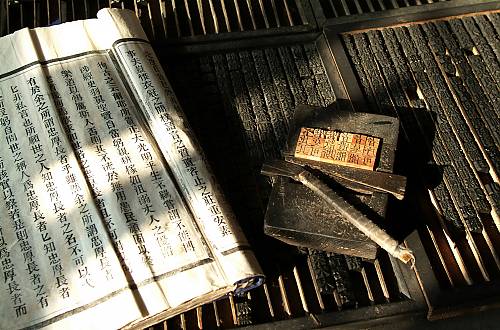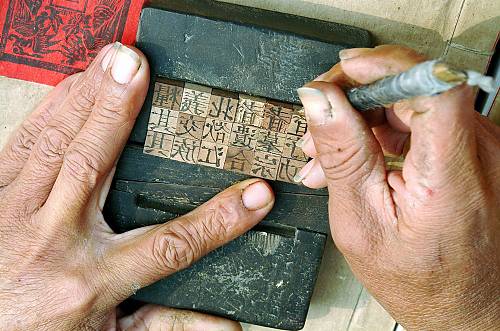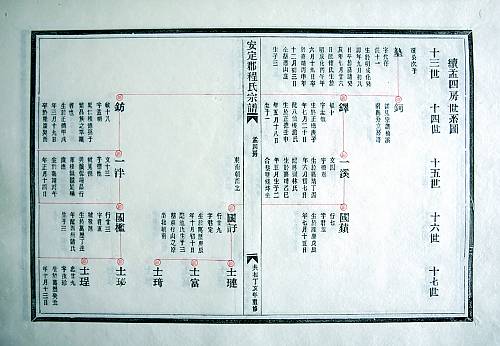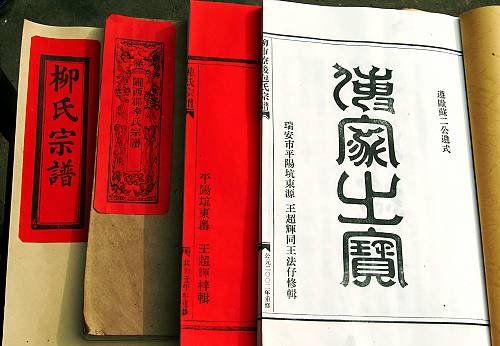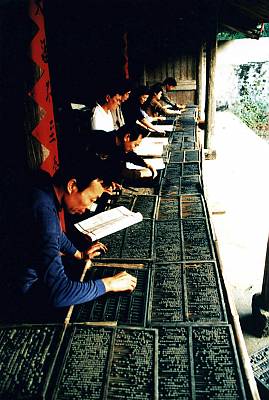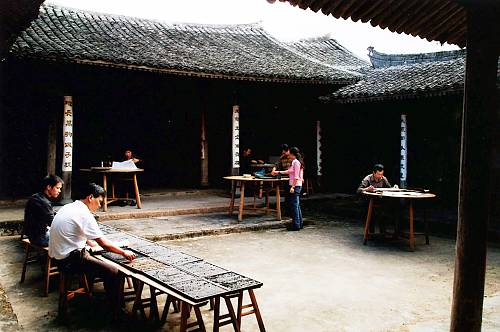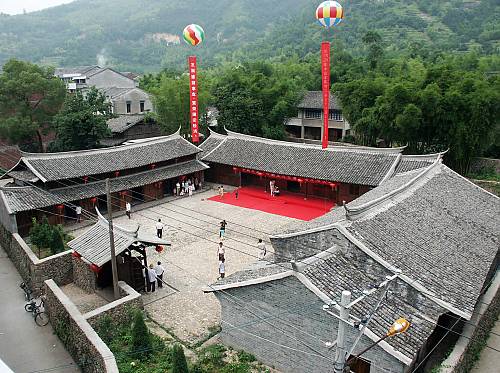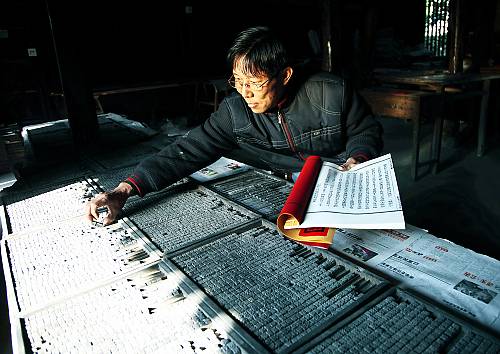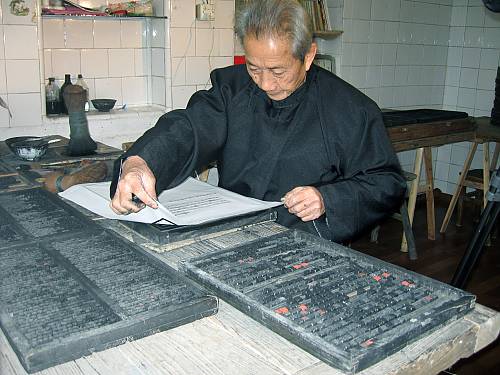Rapport sur l'état d'un élément inscrit sur la liste du patrimoine culturel immatériel nécessitant une sauvegarde urgente
A. Page de couverture
A.1.
État partie
Nom de l'État partie
Chine
A.2.
Date du dépôt de l'instrument de ratification, d'acceptation, d'approbation ou d'adhésion
Elle peut être consultée en ligne.
Date of deposit of the instrument of ratification, acceptance, approval or accession
2004-12-02
A.3.
Élément inscrit sur la Liste de sauvegarde urgente qui fait l'objet du présent rapport
Nom de l'élément
Wooden movable-type printing of China
Inscrit en
2010
État(s) soumissionnaire(s)
Chine
A.4.
Période considérée dans le présent rapport
Veuillez indiquer la période couverte par le présent rapport.
Reporting period covered by this report
01-01-2016 - 31-12-2018
A.5.
Autres éléments inscrits sur la Liste de sauvegarde urgente, le cas échéant
Veuillez établir une liste de tous les autres éléments présents sur le territoire de votre pays qui sont inscrits sur la Liste de sauvegarde urgente et indiquer en quelle année ils y ont été inscrits ; pour ce qui est des éléments multinationaux, veuillez indiquer quels autres États sont concernés.
Other elements inscribed on the Urgent Safeguarding List, if any
La technique des cloisons étanches des jonques chinoises (2010)
Le Meshrep (2010)
Le Yimakan, les récits oraux des Hezhen (2011)
A.6.
Synthèse du rapport
Veuillez fournir une synthèse du rapport, qui permette au grand public de comprendre l'état actuel de l'élément, mentionne toute incidence positive ou négative de son inscription et fasse état des mesures de sauvegarde mises en œuvre pendant la période considérée et leur possible mise à jour les années suivantes.
Executive summary of the report
According to relevant historical records, movable-type printing technique was invented in the Northern Song Dynasty (1041-1048 AD). Nowadays, with the popularity of modern printing technology, the viability of the element has been seriously endangered, and its transmission has been in a predicament. The inscription of the element on the List of Intangible Cultural Heritage in Need of Urgent Safeguarding in November 2010 (Decision 5.COM 5.2) has triggered discussions among Chinese people about intangible cultural heritage and their viability in the modern times. In this process, the public become increasingly aware of the importance of safeguarding intangible cultural heritage to the promotion of cultural diversity and human creativity. In particular, the communities, groups, and individuals concerned renewed their understanding of the element and its related folk custom and cultural space. The solidarity and cultural identification of the local communities were strengthened, and the visibility of the element and that of intangible cultural heritage in general were also promoted.
During the last reporting period, the safeguarding measures implemented and their effectiveness were confirmed by the Committee (Decision12.COM 8.c.7). It was pointed out in this Decision that, through establishing audio-visual documentation, providing capital support for bearers and practicing institutions, the State Party made positive efforts in safeguarding the element. In the current reporting period, in order to ensure the viability of the element, joint efforts were made between relevant communities, groups and individuals, and the competent bodies and Chinese governments at all levels. The safeguarding measures were implemented in deep cooperation among the above-mentioned stakeholders:
(1) The bearers were encouraged to take on apprentices to activate the internal vitality of the traditional modes of transmission. The neighboring communities were also mobilized and encouraged to be involved in practicing the movable-type printing technique. At present, 17 bearers commanding the whole process of the technique were identified as representative bearers. In addition, the number of practitioners directly involved in the transmission of the technique was about 240. Compared with the situation before the inscription, the number of bearers commanding the whole process of the technique was increased by 15, and the number of practitioners directly involved in the practice of the technique was increased by more than 130 (including 23 females).
(2) In response to Decision 12.COM 8.c.7, in strengthening the role of school education and transmission bases in the transmission of the element, relevant stakeholders continued to support three teaching bases (Kaiyuan Vocational Secondary School, Rui’an Pingyangkeng School and Rui’an Ma’anshan Experimental Primary School) and one transmission center (Wang Chuanqiao Wooden Movable-type Printing Handicraft Studio) during the reporting period, which aimed at ensuring the intergenerational transmission of the element through formal and informal education. In addition, Kaiyuan Vocational Secondary School was included in the second batch of the “Zhejiang List of ICH Teaching and Transmission Bases”, and was proclaimed “Zhejiang Advanced Unit for Popularization and Education of Traditional Culture”. Rui’an Movable-type Printing Association was included in the second batch of “ICH Safeguarding-through-Production Base” in Zhejiang Province.
(3) Such non-governmental organizations as Rui’an Movable-type Printing Association carried out training sessions for bearers and practitioners to promote the teaching and exchange of the technique. Two training workshops were respectively held in 2016 and 2018, with 38 apprentices in total participated. The Association continued to engage in the business printing editions of ancient books since 2015. By using the movable-type printing technique, it also printed important ancient books such as Doha and etc. The viability of the element was promoted through the market-oriented operation and management.
(4) The Movable-type Printing Culture Exhibition Hall was repaired and expanded to accommodate richer exhibits, objects and tools. Safeguarding measures regarding the preservation of ancient buildings in Dongyuan was confirmed and implemented. The Dongyuan Village was further developed into a community-based traditional cultural transmission base. As a result, the visibility of the element was promoted, the public’s recognition and understanding over it and its related cultural space and folklore were deepened, more and more people were summoned and became voluntarily involved in the safeguarding of ICH in general.
A.7.
Personne à contacter pour la correspondance
Donnez le nom, l'adresse et les coordonnées d'une personne à qui toute correspondance concernant le rapport doit être adressée.
Titre (Mme/M., etc.)
Mr
Nom de famille
ZHENG
Prénom
Jianjun
Institution/fonction
Center for the Safeguarding of the Intangible Cultural Heritage in Rui’an City, Zhejiang Province, China / Directorhanges and Cooperation Ministry of Culture and Tourism of China
Adresse
FL-4 Cultural Center, No. 8 Jiefang Zhonglu Road, Rui’an City, Zhejiang Province, China, 325200
Numéro de téléphone
0086-577-65877058
Adresse électronique
rasfy@sina.com
Autres informations pertinentes
www.muhuozi.com (website for Wooden movable-type printing of China)
B
Ms
B. État de l'élément inscrit sur la Liste de sauvegarde urgente
Veuillez vous référer au dossier de candidature ou aux précédents rapports, le cas échéant, pour savoir quand établir un rapport sur l'état actuel de l'élément et ne rendez compte que des changements pertinents survenus depuis la date de son inscription sur la Liste ou depuis le précédent rapport. Les dossiers de candidature, les calendriers spécifiques et les précédents rapports, le cas échéant, sont disponibles à l'adresse suivante : https://ich.unesco.org ou peuvent être demandés au Secrétariat.
L'État partie s'efforce de prêter une attention particulière au rôle du genre et d'assurer la plus large participation possible des communautés, des groupes et, le cas échéant, des individus concernés ainsi que des organisations non gouvernementales pertinentes pendant le processus de préparation de ce rapport ; il lui est demandé au point D ci-dessous de décrire de quelle manière il y est parvenu.
B.1.
Fonctions sociales et culturelles
Expliquez les fonctions, les significations sociales et culturelles de l'élément aujourd'hui, au sein et pour ces communautés, les caractéristiques de ses détenteurs et de ses praticiens et décrivez, entre autres, toute catégorie de personnes exerçant un rôle ou des responsabilités spécifiques vis-à-vis de l'élément. Une attention particulière devrait être accordée à tout changement pertinent susceptible d'avoir des répercussions sur le critère d’inscription U.1 (« L’élément est constitutif du patrimoine culturel immatériel tel que défini à l'article 2 de la Convention »).
Social and cultural functions
Movable-type printing technique is considered by the communities, groups, and individuals concerned as an important part of their cultural heritage. For the bearers, it is not only the technique transmitted from generation to generation within family, but also the important means for livelihood. The technique is mainly used in the compiling and printing of clan genealogies in local communities to record the history and kinship of their families. Therefore, as the carrier of the local history and culture, the movable-type printing technique not only provides technical support for the transmission of local culture, but also functions as an important media to maintain the inter-generational connection among the community members. Having spread to other areas in China, the element plays an important role in the social and cultural development of these places, and becomes an important cultural carrier for different groups to understand and recognize their history.
The essence of movable-type printing technique originates from the process where certain cultural and artistic concepts are updated and transmitted, and from the process where a scientific and practical system of technique is passed down from one generation to the next. Although the technique system has relatively fixed patterns and matured production processes, there is no standardized working models to be followed, which provides enough room for different communities, groups, and individuals to give full play to their creativity. The technique is mainly transmitted from bearers to their apprentices within families. A special ceremony for taking on apprentices is strictly abided. Individuals should be recognized by the local community before becoming a bearer in the system of intergenerational transmission. Decision 12.COM 8.c.7 pointed out that, the role of bearers in the development of the element should be emphasized and attached with great importance. Craftsmen engaged in the technique are not only experts of traditional printing techniques, but also bearers of Chinese genealogical culture. They are responsible for the editing, printing, and binding of different clan genealogies. Therefore, they are also known as the “Masters of Genealogy”. Generally speaking, women practitioners are weaker in strength, so they mainly work on the typesetting, printing, and binding, and so on. Wu Shumei, the daughter-in-law of Wang Chuanqiao, is a representative bearer of the element. Since 2017, she has overcome physical limitations of the female and started to learn engraving and other techniques used to be practiced mainly by male bearers. Through constant efforts, these female bearers have basically grasped the whole process of wooden movable-type printing technique and become an important force among the representative bearers of the element.
At present, the communities in which the element is being practiced and transmitted include the old areas of Dongyuan Village of Gaolou Town and Xiqian Village of Caocun Town in Rui’an City, as well as some adjacent and new areas such as Pingyang County. In these communities, representative bearers such as Wang Chaohui, Lin Chuyin, Wang Chuanqiao and Wang Zhiren continue to work on the printing, revision, compiling and preservation of clan genealogies for local communities. The above-mentioned representative bearers have carried out regular teaching activities on movable-type printing technique in middle and primary schools. By teaching the historical and cultural knowledge associated with the element to the students, these representative bearers continue to play an indispensable role in the safeguarding and transmission of the element.
B.2.
Analyse de sa viabilité et risques auxquels il est actuellement exposé
Décrivez le degré actuel de viabilité de l'élément, en particulier la fréquence et l'étendue de sa pratique, la vigueur des modes de transmission traditionnels, la composition démographique des praticiens et des publics, et sa durabilité. Veuillez aussi identifier et décrire les facteurs qui, le cas échéant, constituent une menace pour la pérennité de la transmission et de la représentation de l'élément et indiquez le degré de gravité et de proximité de tels facteurs, en accordant une attention particulière à tout renforcement ou affaiblissement de la viabilité de l'élément suite à son inscription.
Assessment of its viability and current risks
Current level of viability of the element
(1) Within the communities where the element is viable, the element still functions culturally in commemorating ancestors, transmitting history, and continuing identification. Thus, there are still comparatively great demands in the markets of Zhejiang, Fujian, and other places. For example, bearers in Dongyuan Village received more than 150 orders in 2016. The payment for these orders relied on the scale of the clan genealogy, and the annual income of a bearer was about 60,000 to 80,000 RMB, which was slightly increased and close to the average annual salary of a local skilled worker. This is in a sense helpful to the stabilization of local bearers and to the ensuring of the viability of the element.
(2) After inscription, the local communities, NGOs, and governmental institutions actively supported folk clans to conduct research on their genealogies, aiming at expanding the range for the application of movable-type printing technique. As a result, the market demand for the technique was in fact increased. In practice, community members also voluntarily used the technique to compile and print clan genealogies to ensure the frequency of its practice, thus ensuring the actual function of the element in the communal cultural system.
(3) In addition to the compiling and printing of clan genealogies, the publication of more ancient books further increased the practice frequency of the element and promoted its viability. For example, the local governments entrusted the Movable-type Printing Association to edit and publish 26 types of ancient books. Relevant communities were encouraged by the initiative and sought to sustain the cultural tradition through regular compiling and printing clan genealogies. As a result, a total of 31,000 books (as of December 2018, 1,000 to 3,000 copies for each type) were printed and for sale in bookshops. Some of the books were presented as gifts in foreign exchange. This further expanded the range of application for the movable-type printing technique.
(4) Representative bearers actively developed souvenirs related to the wooden movable-type printing technique, which effectively increased the number of related bearers and practitioners. For example, Wang Chuanqiao founded his Wooden Movable-type Printing Handicraft Studio in Dongyuan Village in 2013, which not only increased the number of apprentices and practice frequency of the element, but also raised the income of relevant practitioners and bearers.
Current risks to the element
(1) The traditional craftsmanship is under the impact of the modern technology and struggles in the contemporary social context. Considering the cost, many clans gave up movable-type printing technique for the relatively cost-saving computer digital printing in revising and compiling clan genealogies. As a result, the traditional market for the technique shrank and was occupied by the new technology. For example, in the past five years, more than 20 clan genealogies in Rui’an were printed with the computer digital printing, which was about 5% higher in number compared to the previous level.
(2) Movable-type printing technique is of complicated process with high technical contents. The bearer should not only master certain knowledge about the history and culture of the element, but also learn and practice brush handwriting of Chinese calligraphy and hand-operated engraving techniques. It usually takes at least two years for an apprentice to command the whole set of movable-type printing technique. Due to the utilitarian oriented values and rapid rhythm of development in modern society, together with the lack of incentives and securing mechanism, the young people are generally not interested in the safeguarding of the element.
(3) At present, movable-type printing technique is mostly used in rural areas. Although the payment is higher than before, it still remains at a comparatively low level. Therefore, some craftsmen need to do part-time jobs, or even change career, which restrains the sustainable development of the element.
(4) Currently, there are 17 representative bearers who master the whole set of movable-type printing technique (four have passed away since last reporting period). All of them are middle-aged or elderly people above 50 years old. The viability of the element may be further endangered in the future.
B.3.
Mise en œuvre des mesures de sauvegarde
Veuillez rendre compte des mesures de sauvegardes qui ont été décrites dans le dossier de candidature et dans un précédent rapport, le cas échéant. Décrivez de quelle manière elles ont été mises en œuvre et ont contribué de façon substantielle à la sauvegarde de l'élément au cours de la période considérée, en tenant compte des contraintes externes ou internes telles que des ressources limitées. Incluez en particulier des informations sur les mesures prises afin d'assurer la viabilité de l'élément en permettant à la communauté d'en poursuivre la pratique et la transmission. Fournissez les renseignements suivants en ce qui concerne la mise en œuvre de l’ensemble des mesures de sauvegarde ou du plan de sauvegarde :
B.3.a.
Objectifs et résultats
Indiquez quels objectifs principaux ont été atteints et quels résultats concrets ont été obtenus pendant la période considérée.
Objectives and results
(1) The safeguarding of the bearers: to continue the existing national mechanism of four-level (county, municipal, provincial and national levels) identification and recognition of representative bearers. A total of 17 representative bearers of movable-type printing technique were identified (including one departed bearer). About 240 people directly participated in the practice, including over 50 females (one of them was qualified to be identified as the representative bearer). Female practitioners played important roles in the transmission of the element, which was a positive signal for its sustainable development. In addition, Dongyuan Movable-type Printing Company in Rui’an continued to support relevant bearers for the production, practice and transmission of the element, and to improve its practice frequency through market-oriented management and sale.
(2) Promoting visibility: to continue supporting Rui’an Movable-type Printing Association to construct two teaching bases for the transmission of the element. Rui’an Dongyuan Movable-type Printing Culture Exhibition Hall was renovated and enlarged, and relevant historical antiquities, visual materials and on-spot demonstration sessions were added to the existing layout. As the Transmission Base of ICH and the Education Base of Traditional Culture in Wenzhou City, the Hall housed a series of exhibitions, which not only contributed to the promotion of the visibility of the element, but to that of the ICH in general among the public.
(3) Documentation: since 2016, on the basis of the general investigation over the communities and bearers concerned, the cultural eco-environment of the element, editions of ancient books, and etc., the modern digital technology was applied to record and preserve the core factors of the element such as the printing processe, folklore, taboos and tools. 486 G of videos, 6,560 M of photos, 308 M of texts, and more than 120 pieces of other materials were collected.
(4) Institutional Support: The Rui’an Center for the Safeguarding of Intangible Cultural Heritage was directly in charge of safeguarding the element. By clarifying relevant rights, obligations, and responsibilities, the Steering Group for Safeguarding Movable-type Printing Technique in Rui’an played a coordinative role ensuring the effective implementation and supervision of relevant safeguarding measures.
(5) Legislation: The Intangible Cultural Heritage Law of the People’s Republic of China, and the Regulations on Safeguarding ICH of Zhejiang Province, provided a legal basis for the implementation of the safeguarding measures proposed. Meanwhile, based on the local context, Rui’an City also drew up the specific guidelines to facilitate the safeguarding of the element, which substantially based the safeguarding work on the laws or regulations.
B.3.b.
Activités de sauvegarde
Dressez la liste des principales activités menées au cours de la période considérée pour obtenir ces résultats escomptés. Veuillez décrire les activités en détail en mentionnant leur efficacité et tout problème rencontré dans leur mise en œuvre.
Safeguarding activities
Focusing on bearers and increasing the frequency of practice
(1) The representative bearers were identified on the basis of the recommendation of the communities concerned. In order to improve their income and stimulate their enthusiasm to practice and transmit the element, governments at different levels provided financial support for the bearers. In addition, some assistance was also provided in terms of venues, reduction or exemption of taxes, financial loans, and administrative examination and approval.
(2) General investigation on the element was organized, and archives were established with modern multimedia technology. The viability of movable-type printing technique was evaluated by experts with the participation of the communities and bearers concerned. Through the complete documentation incorporating audio, visual, and textual materials, the historical development, the status of transmission, as well as other important information, were further confirmed.
(3) Training workshops were organized at the education and transmission base every two years. The transmission of the element and the training of the next generation of masters were centered around the representative bearers concerned. Rui’an Dongyuan Movable-type Printing Culture Exhibition Hall and Wang Chuanqiao Wooden Movable-type Printing Handicraft Studio organized a number of transmission activities. Meanwhile, they developed tourist souvenirs using cultural factors of the element, which in a way created opportunities for the apprentices to practice. Moreover, the income of relevant bearers was correspondingly increased, and more job opportunities were created for the local communities.
(4) Through the cooperation with the local government, taking advantage of various state-oriented projects to publish hard copies of ancient books, the practice frequency of the element, as well as its relevance to the social needs, were promoted. 15 important ancient books, including the Art of War, were reprinted since 2011. This not only provided an opportunity for the bearers and practitioners concerned to practice the element, but also promoted the influence and visibility of the element.
Dissemination and education
(1) From June to July every year, bearers were organized to participate in on-site activities on Rui’an Cultural Heritage Day to demonstrate the whole process of movable-type printing technique. They were also organized to participate in the ICH exhibition and exchange activities in other places, such as the thematic exhibition “Cultural Transmission and Future Prospect - Diversified Interaction between Chinese Movable-Type Printing and Modern Chinese Characters Ink Painting” held in Australia in December 2018, which further extended the influence of the element and attracted more attention from the public. On-site demonstrations by bearers and experiencing projects for visitors were added as well, in order to promote movable-type printing technique in the society.
(2) Various kinds of activities to introduce movable-type printing technique into campuses were organized, and teaching bases for the transmission of movable-type printing technique were established at middle and primary schools. Popular textbooks such as Movable-type Printing Technique in Dongyuan of Rui’an and Movable-type Printing Technique in Rui’an were adopted in the teaching of wooden movable-type printing technique at middle and primary schools, which improved the awareness of the importance of safeguarding ICH among young people.
(3) More than 200 pieces of news were released in different media. 10 thematic TV documentaries were broadcast since 2015, giving extensive introduction and dissemination of the element. This had a good social impact in the public and further strengthened the public opinion to support the safeguarding of the element.
(4) Through platforms and occasions such as the national Cultural and Natural Heritage Day, the UNESCO’s 2003 Convention for the Safeguarding of the Intangible Cultural Heritage and relevant national laws and regulations were highlighted and introduced. As a result, the awareness of the importance of safeguarding intangible cultural heritage among the public was promoted. The attention of the public was further attracted to the safeguarding of the element and ICH in general.
(5) To explore the sustainable development of the element and improve the visibility of the element among the academic community, and to provide intellectual support for the theoretical research and safeguarding of the element, the “China Rui’an Movable-type Printing Technique Seminar” was continually held. Coordinated by China Movable-type Printing Technique Expert Committee, extensive cooperation with colleges and folk-art associations was established to intellectually support the long-term safeguarding and development of the element.
Problems to be solved
(1) Lack of investment, the form of fund-raising remains simplex. Since the financial support for the safeguarding mainly comes from government investment, diversified fund-raising channels need to be explored. In addition to government investment, at the level of community and civil organization, their ways of contribution to the safeguarding of the element rely on providing human power or in-kind support. At present, only a few representative bearers like Wang Chuanqiao have the capability to raise funds on their own by developing and selling handicrafts or souvenirs related to the element. Other bearers can only rely on limited social and government support to continue their transmission and practice.
(2) The local competent bodies lack of relevant experiences in safeguarding the element, and the measures taken remain simplex. Currently, progress has been made by organizing thematic exhibitions of representative works for relevant bearers at the local exhibition halls and museums, which to an extent has improved the bearers’ income and stimulated their enthusiasm in the safeguarding efforts. However, influence still remains insignificant due to limited exposure. For the next stage, more funds should be provided in collecting the representative works of bearers and the size and frequency of the thematic exhibition should be increased. In addition, government could explore more diversified safeguarding methodology such as: drawing up relevant rules and setting up a rewarding mechanism to encourage social organizations to invest in the safeguarding; providing positions in the government for those apprentices of superb skills.
(3) The safeguarding measures lack of diversified methodologies, and the sustainable development of the element lacks of institutional guarantee. For young bearers (most of them are apprentices of identified bearers), they could hardly be identified as representative bearers due to the limited time in practicing the technique and their age. Therefore, it is difficult to work out the standard or procedure to provide them with financial aids (as the compensation for their work), which results in a fact that less young people especially the females are attracted to the safeguarding of the element. In addition, there is still no corresponding mechanism to encourage and guarantee the folk organizations (mainly the Clan Genealogy Compiling Committee) to use the element in the compiling and printing of clan genealogies.
B.3.c.
Participation de communautés, de groupes ou d'individus aux activités de sauvegarde
Veuillez décrire de quelle manière les communautés, les groupes ou, le cas échéant, les individus ainsi que les organisations non gouvernementales pertinentes ont participé de façon effective à l'exécution des mesures de sauvegarde, y compris en termes de rôles du genre. Décrivez le rôle joué par l'organisation ou l'organe chargé de l'exécution (dénomination, informations de référence, etc.) et les ressources humaines qui ont été mises à disposition pour la mise en œuvre des activités de sauvegarde.
Participation of communities, groups or individuals in the safeguarding activities
Rui’an Movable-type Printing Association is a NGO founded voluntarily by the bearers and practitioners of the wooden movable-type printing technique. Currently, it has more than 130 members. Taking advantage of its large number of members, the association took many measures for the safeguarding and transmission of the element. For example, it purchased the raw materials and used the wooden movable-type technique to print hard copies of ancient books. It also organized activities to enhance the internal communication among the bearers. In January 2017, the Association was listed on the second batch of “ICH Safeguarding-through-Production Base” in Zhejiang.
The community member Wu Xiaohuai has been engaged in the research of wooden movable-type printing technique for a long time. In 2017, he was entrusted by the government to lead the decoration of the newly built Dongyuan Movable-type Printing Culture Exhibition Hall. Through the event, the safeguarding efforts and research results of the element were fully demonstrated and represented in visual, textual and in-kind forms.
The website of movable-type printing technique in China (www.muhuozi.com) hosted by Rui’an Movable-type Printing Association maintains normal operation. It covers 10 columns, including “introduction to the association”, “latest news”, “history of the technique”, “feature of the technique”, “business scope”, “bearers”, “exhibition and impact”, “transmission and safeguarding”, “members of the association” and “message board”. The website continues to play an important role in the dissemination and promotion of the element.
The members of China Movable-type Printing Technique Expert Committee mainly consist of the members from the Chinese Folk Literature and Art Association. All of them are local experts, who are responsible for the evaluation of ICH, as well as facilitating the identification of representative bearers and the transmission of the element.
From 2015 to 2018, a total of 126,000 visitors and professionals from the country and abroad visited the Rui’an Dongyuan Movable-type Printing Culture Exhibition Hall. The development of cultural tourism and creative souvenirs, provided opportunities for the apprentices to practice, thus improving bearers’ income and creating more jobs for the local community.
As competent bodies, the Bureau of Culture, Radio, TV, Film, Press and Publication in Rui’an City, Zhejiang Province and the Center for the Safeguarding of Intangible Cultural Heritage in Rui’an City, Zhejiang Province, play a coordinative role in the implementation of the safeguarding measures. Nearly 48,000 people from relevant communities, groups, government at all levels and competent bodies, are involved in the safeguarding of the element.
B.3.d.
Calendrier
Indiquez, sous forme de calendrier, les dates de mise en œuvre de chacune des activités.
Timetable
Governmental resources
2015-2018: filming documentaries of movable-type printing technique (30,000 RMB)
2015-2018: collecting information and images of movable-type printing technique (20,000 RMB)
2015-2018: financial aid for representative bearers (300,000 RMB)
2015-2018: making brochures for the publicity of movable-type printing technique (50,000 RMB)
2015-2018: financial aid for bearers (140,000 RMB)
2015-2018: participating in cultural fairs and other domestic activities (90,000 RMB)
2015-2018: financial aid for transmission of books made by the Movable-type Printing Technique (95,000 RMB)
April 2016: organizing the movable-type printing technique competition and evaluation of apprentices training (10,000 RMB)
2016-2017: building the new movable-type printing technology exhibition hall (4,100,000 RMB)
2017-2018: renovating the old movable-type printing technology exhibition hall (1,500,000 RMB)
2016-2018: purchasing equipment for the transmission of movable-type printing technique (180,000 RMB)
2016-2018: purchasing equipment for establishing archive and database (100,000 RMB)
2017: organizing the first Wooden Movable-Type Printing Culture and Tourism Festival (180,000 RMB)
Total: 6,795,000 RMB
Other resources
2016-2018: organizing transmission and safeguarding activities by Rui’an Movable-type Printing Association (160,000 RMB raised by members)
2016-2018: establishing teaching bases and opening training classes for the transmission of the element (50,000 RMB; Kaiyuan Secondary Vocational School and Rui’an Movable-type Printing Association provided the venue, and students provided tools)
2016-2018: organizing bearers to participate in various kinds of transmission and practice activities (40,000 RMB; bearers participated in the transmission and practice activities, and relevant communities provided the venue)
2016-2018: printing hard copies of ancient books like Doha and clan genealogies with wooden movable-type printing technique (1,180,000 RMB invested by relevant social resources; groups and individuals provided human power and technical resources)
2017: organizing movable-type printing exhibitions and safeguarding seminars (20,000 RMB funded by relevant groups)
2016-2018: organizing education activities introducing ICH into schools, communities and villages (80,000 RMB; schools and communities provided venues and human power, and bearers participated in the publicity and education activities)
2016-2018: compiling and publishing Movable-type Printing Technique textbooks (20,000 RMB funded by relevant groups)
2016-2018: supporting bearers for the transmission and recreation of the element (50,000 RMB funded by relevant groups)
2016-2018: collecting the tools and works of movable-type printing technique (250,000 RMB, integrated resources from the government and society)
Total: 1,850,000
Central government financial support
2016-2018: competent bodies from the central government allocated a total of 300,000 RMB to safeguard the element.
B.3.e.
Dépenses budgétaires
Veuillez fournir le détail des montants des fonds utilisés pour la mise en œuvre de chaque activité (si possible, en dollars des États-Unis), en indiquant dans chaque cas l’origine du financement (sources gouvernementales, contributions en nature des communautés, etc.).
Budget
Governmental resources
2015-2018: filming documentaries of movable-type printing technique (30,000 RMB)
2015-2018: collecting information and images of movable-type printing technique (20,000 RMB)
2015-2018: financial aid for representative bearers (300,000 RMB)
2015-2018: making brochures for the publicity of movable-type printing technique (50,000 RMB)
2015-2018: financial aid for bearers (140,000 RMB)
2015-2018: participating in cultural fairs and other domestic activities (90,000 RMB)
2015-2018: financial aid for transmission of books made by the Movable-type Printing Technique (95,000 RMB)
April 2016: organizing the movable-type printing technique competition and evaluation of apprentices training (10,000 RMB)
2016-2017: building the new movable-type printing technology exhibition hall (4,100,000 RMB)
2017-2018: renovating the old movable-type printing technology exhibition hall (1,500,000 RMB)
2016-2018: purchasing equipment for the transmission of movable-type printing technique (180,000 RMB)
2016-2018: purchasing equipment for establishing archive and database (100,000 RMB)
2017: organizing the first Wooden Movable-Type Printing Culture and Tourism Festival (180,000 RMB)
Total: 6,795,000 RMB
Other resources
2016-2018: organizing transmission and safeguarding activities by Rui’an Movable-type Printing Association (160,000 RMB raised by members)
2016-2018: establishing teaching bases and opening training classes for the transmission of the element (50,000 RMB; Kaiyuan Secondary Vocational School and Rui’an Movable-type Printing Association provided the venue, and students provided tools)
2016-2018: organizing bearers to participate in various kinds of transmission and practice activities (40,000 RMB; bearers participated in the transmission and practice activities, and relevant communities provided the venue)
2016-2018: printing hard copies of ancient books like Doha and clan genealogies with wooden movable-type printing technique (1,180,000 RMB invested by relevant social resources; groups and individuals provided human power and technical resources)
2017: organizing movable-type printing exhibitions and safeguarding seminars (20,000 RMB funded by relevant groups)
2016-2018: organizing education activities introducing ICH into schools, communities and villages (80,000 RMB; schools and communities provided venues and human power, and bearers participated in the publicity and education activities)
2016-2018: compiling and publishing Movable-type Printing Technique textbooks (20,000 RMB funded by relevant groups)
2016-2018: supporting bearers for the transmission and recreation of the element (50,000 RMB funded by relevant groups)
2016-2018: collecting the tools and works of movable-type printing technique (250,000 RMB, integrated resources from the government and society)
Total: 1,850,000
Central government financial support
2016-2018: competent bodies from the central government allocated a total of 300,000 RMB to safeguard the element.
B.3.f.
Efficacité globale des activités de sauvegarde
Procédez à une évaluation globale de l'efficacité des activités menées pour parvenir aux résultats escomptés et de l'utilisation des fonds nécessaires à leur mise en œuvre. Veuillez indiquer de quelles manières les activités ont contribué à l’obtention des résultats et si d'autres activités auraient été mieux adaptées à cette fin. Indiquez aussi si les mêmes résultats auraient pu être obtenus avec de moindres ressources financières, si les ressources humaines disponibles étaient appropriées et si les communautés, groupes et individus concernés auraient pu participer davantage.
Overall effectiveness of the safeguarding activities
(1) The rescuing recording and digital preservation of the element were successfully conducted, yielding fruitful achievements in documentation. A large amount of textual, visual, and audio information was collected and processed, especially the full records of the core components, technical process and characteristics, folk taboo and tools of the element, providing a solid basis of the thematic database under construction.
(2) The channels for raising funds are more diversified and fund utilization is more effectively supervised by all stakeholders. Governments at all levels, relevant communities, groups and bearers applied the safeguarding-through-production methodology, focusing mainly on printing works with the wooden movable-type printing technique. More than 100 clan genealogies or copies of ancient books were printed annually. Although different clans kept the tradition to revise their clan genealogies regularly for a long time, the revision of each clan varied in the period, range and quantity. Therefore, the channels for raising funds for the safeguarding of the element were diversified. When every time the clan genealogy was to be revised, a Council of Clan Elders would be established, which was responsible for managing and supervising the use of the fund to ensure its efficiency and avoid waste. In addition, the printed copies of clan genealogies needed to be examined by the Council, which in fact guaranteed the high quality of these copies.
(3) The number of bearers and practitioner increased. More people got involved in the safeguarding activities. Representative bearers are provided with financial aid and subsidies, as well as venues for transmission to stabilize the existing traditional transmission model and groups of bearers. Although the financial aid has been greatly increased, the effect is not satisfactory. It is suggested to further increase investment and subsidies in representative bearers.
(4) Through dissemination, education and popularization of the element, its visibility was correspondingly promoted. More and more people became known about the element. Currently, limited investment achieved satisfactory results. For the next step, this successful experience should be followed. In addition, measures such as introducing ICH into communities and schools, compiling local textbooks, publishing monographs, shooting films and documentaries, and etc., were proved effective in promoting the visibility of the element. Experiences as such indeed contributed to the awareness raising among the public, disseminating knowledge about the element, and creating a good atmosphere in the society. Nevertheless, attention should be paid to the exploration of new channels and methods in the dissemination of the element.
(5) The extensive participation of non-governmental industrial organizations and professional institutions has increased the efficiency in the comprehensive utilization of different resources. Institutes of higher learning and social organizations have participated in the safeguarding efforts by implementing various kinds of academic exchange and establishing the mechanism for providing scientific basis for safeguarding intangible cultural heritage. Although certain achievements have been made in the safeguarding work, we should still further sum up the experience and establish norms to ensure the targeted safeguarding and improve the efficiency in comprehensive utilization of different resources.
C
Zhu
C. Mise à jour des mesures de sauvegarde
C.1.
Plan de sauvegarde mis à jour
Veuillez fournir une mise à jour du plan de sauvegarde inclus dans le dossier de candidature ou dans le précédent rapport. En particulier, veuillez donner des informations détaillées comme suit :
- a. Quels sont les objectifs principaux visés et les résultats concrets attendus ?
- b. Quelles sont les activités principales à mener pour atteindre ces résultats attendus ? Veuillez décrire les activités en détail et dans l'ordre d'exécution, en démontrant leur faisabilité.
- c. Comment le ou les États parties concernés soutiennent-ils la mise en œuvre du plan de sauvegarde mis à jour ?
Updated safeguarding plan
(1) To collect the representative works of bearers and organize thematic exhibitions at local exhibition halls and museums, and to promote the enthusiasm of bearers and increase their income. Dongyuan Movable-type Printing Culture Exhibition Hall has paid Wang Chaohui, Wang Chuanqiao, Wu Kuizhao and other bearers, for collecting their representative works exhibited in the new Dongyuan Movable-type Printing Culture Exhibition Hall. The Hall even keeps a regular and long-term session for them to present their works. This widely praised action attracts a large number of tourists, experts and scholars, and the exhibition even becomes an eye-catching event of the Hall. Meanwhile, Rui’an Museum also provided special funds and venues to organize exhibitions of the representative bearers’ works. These new efforts would not only enhance the influence and visibility of the element, but greatly stimulate the enthusiasm of the bearers and increase their income.
(2) To develop apprentice training mechanism, enlarge the team of bearers, and secure the dynamic transmission mode of the element. Movable-type printing technique training workshops will be organized every two years by Rui’an Center for the Safeguarding of Intangible Cultural Heritage and Rui’an Movable-Type Printing Association, aiming at enlarging the team of bearers. Each training session will last three months. Apprentices of representative bearers in Rui’an city, students from middle and primary schools who are willing to learn the technique, and teachers who teach movable-type printing classes in schools, will be the targeted audiences of the training. Representative bearers including Wang Chuanqiao and Wang Zhiren will serve as key lecturers for the demonstration of the whole process of the element including calligraphy, engraving, typesetting, printing and bookbinding. Rui’an Center for the Safeguarding of Intangible Cultural Heritage will also sign agreements with each representative bearer to take apprentice, stipulating that every representative must ensure at least one of their apprentices takes the training courses. Based on past experiences---the first training workshop (October 2016 - January 2017) had 20 participants and the second (July 2018 - October 2018) had 18 participants (including 11 middle and primary school students), this mechanism is proved effective and will be followed in the next stage of the implementation.
(3) To explore the possibility of promoting the dynamic transmission of the element through marketization. Wang Chuanqiao and his daughter-in-law successfully developed cultural creative products by combining wooden movable printing technique and block printing technique. Wang Fawan, the 34th generation of Dongyuan wooden movable-type printing technique, opened five experiencing centers in Dongyuan and Rui’an. These cases offer beneficiary experiences for the dynamic transmission of the element through marketization. Following the same idea, it is planned to develop relevant cultural creative products related to the element, and to promote their sales through internet. It is hoped that the overall profit of practicing the element will be increased, and the relevance of the element to the current social context will be strengthened through market- oriented operations.
(4) To explore the innovation to integrate three elements: movable-type printing, Zhima wood block printing technique and Pingzhi paper making technique, and to develop relevant handcrafts and artworks. The issue of the integration of the three elements extensively attracts the public’s attention and triggers comprehensive discussions at the local level. After months of efforts, Wang Chuanqiao and other representative bearers from Rui’an and Ouhai successfully printed ancient-style Wenzhou pictures on the pingzhi paper. Such case provides new scenario for the safeguarding of the movable-type printing technique. New ways of the creative integration of different ICH elements will be explored, which aims at enhancing the added value of relevant ICH products and ensuring the viability of relevant ICH elements.
(5) To provide institutional guarantee, including the rewarding and encouraging mechanism, for various stakeholders to be involved in the safeguarding of the element. Wenzhou and Rui’an municipal governments will ensure the implementation of relevant laws and regulations. For those bearers who pay their apprentices will be encouraged and rewarded by the local government. In addition, various social stakeholders will be encouraged to support and invest in the safeguarding of the element.
(6) Chinese governments at all levels will make greater efforts to safeguard the element. On the basis of more than 3,000,000 RMB the previous expenditure, it is planned to invest at least 300,000 RMB each year to ensure the transmission and development of the element.
C.2.
Calendrier des activités à venir
Veuillez fournir un calendrier du plan de sauvegarde mis à jour (sur une période d’environ quatre ans).
00302,00303,00304,00305,00321,00530
Timetable
Governmental Resources: 1,700,000 RMB
2016-2020: holding three training workshops for wooden movable-type printing techniques (300,000 RMB)
2018-2023: financial subsidies for the young and middle-aged representative bearers (about 400,000RMB)
2018-2022: financial support for NGOs (such as the Clan Genealogy Council) relating to the safeguarding of the element (1,000,000 RMB)
Other Resources: 3,600,000 RMB
2018-2022: foundation of the integration of three elements:
Establishing a research institute (500,000 RMB)
Producing the Pingzhi paper (600,000 RMB)
Engraving creative paintings (500,000 RMB)
Organizing relevant exhibitions and sales (800,000 RMB)
2018-2022: establishing operating studios for the integration and development of wooden movable-type printing and block printing techniques; establishing research and experiencing centers of the element.
Total: 5,300,000 RMB
C.3.
Budget des activités à venir
Veuillez fournir les estimations des fonds requis pour la mise en œuvre du plan de sauvegarde actualisé (si possible, en dollars des États-Unis), en identifiant les ressources disponibles (sources gouvernementales, contributions en nature des communautés, etc.)
Budget
Governmental Resources: 1,700,000 RMB
2016-2020: holding three training workshops for wooden movable-type printing techniques (300,000 RMB)
2018-2023: financial subsidies for the young and middle-aged representative bearers (about 400,000RMB)
2018-2022: financial support for NGOs (such as the Clan Genealogy Council) relating to the safeguarding of the element (1,000,000 RMB)
Other Resources: 3,600,000 RMB
2018-2022: foundation of the integration of three elements:
Establishing a research institute (500,000 RMB)
Producing the Pingzhi paper (600,000 RMB)
Engraving creative paintings (500,000 RMB)
Organizing relevant exhibitions and sales (800,000 RMB)
2018-2022: establishing operating studios for the integration and development of wooden movable-type printing and block printing techniques; establishing research and experiencing centers of the element.
Total: 5,300,000 RMB
C.4.
Participation des communautés
Veuillez décrire comment les communautés, groupes et individus ainsi que les organisations non gouvernementales pertinentes ont été impliqués, y compris en termes de rôles du genre, dans la mise à jour du plan de sauvegarde et comment ils seront impliqués dans sa mise en œuvre.
00045
Community participation
(1) The bearers concerned were actively engaged in the update and implementation of the safeguarding measures. Since 2015, the representative bearers Wang Chaohui, Lin Chuyin, Wang Chuanqiao and Wang Zhiren not only devoted themselves in transmission and safeguarding activities organized by the Teaching Base, but also actively participated in symposiums organized by communities, groups and government for the update of the safeguarding plans. Their proposal of prepaying subsidies for the bearers was adopted by the government. In particular, Wang Chuanqiao had been teaching his daughter-in-law the movable-type printing technique since 2015, who was able to master the whole set of techniques including the extremely difficult engraving technique in 2018. They were both involved in the fieldwork and symposium held in Zeya Town (Ouhai District, Wenzhou City), which aimed at exploring the integration of the three elements. Wang Chaohui, Lin Chuyin and Wang Chuanqiao promised to continue to participate in the implementation of the updated safeguarding plans. They will play active roles in the teaching sessions to involve more people into the transmission of the element. In addition, by searching for more orders and increasing the income through practicing the element, they will try their best to place the transmission of the element on a more solid economic basis.
(2) Communities and groups are the social and cultural foundation for the transmission of the element. Over the past three years, they were deeply involved in the safeguarding of the element in the following two aspects: 1) involvement in the update of the safeguarding plan on clan genealogies; 2) providing support and logistics for the training sessions. Taking Rui'an Movable-type Printing Association as a case, by taking the advantage of its large number of members and practitioners, it substantially promoted the implementation of the safeguarding and transmission plan: purchasing high-quality timbers for professionals to engrave the type matrix; holding annual meetings and thematic conferences to report on the status quo of the element and awarding outstanding bearers and craftsmen; ensuring the normal operation of Dongyuan Movable-Type Printing Co., Ltd., and taking in orders to print the copies of ancient books.
(3) Dongyuan Village, Pingyangkeng Town, Rui’an City actively cooperated with governments at all levels in the implementation of the safeguarding plan, by applying for more fund from the local government, improving the transportation conditions of the Village as a core area of the element, and creating a better living and working environment for the bearers concerned. Dongyuan Village and Rui'an Movable-type Printing Association promised they will continue to try their best to contribute to the safeguarding and transmission of the element. Zhejiang and Rui’an governments promised they will further strengthen the current safeguarding efforts; On the basis of the existing expenditure of 3,000,000 RMB, at least another 400,000 RMB special fund will be invested each year to ensure the transmission and development of the element.
C.5.
Contexte institutionnel
Veuillez indiquer quelles institutions sont en charge de la gestion locale et de la sauvegarde de l'élément inscrit sur la Liste de sauvegarde urgente, notamment :
- a. l'(les) organisme(s) compétent(s) impliqué(s) dans sa gestion et/ou sa sauvegarde ;
- b. l'(les) organisation(s) de la communauté ou du groupe concernée(s) par l'élément et sa sauvegarde.
2004-12-02
Institutional context
a. the competent bodies involved in its management and/or safeguarding
(1) Bureau of Culture, Radio, TV, Film, Press and Publication, Rui’an City, Zhejiang Province
(2) Center for the Safeguarding of the Intangible Cultural Heritage of Rui’an City, Zhejiang Province
b. organizations of the community or group concerned with the element and its safeguarding
(1) Rui’an Movable-type Printing Association, Zhejiang Province
(2) Dongyuan Movable-type Printing Company, Rui’an City, Zhejiang Province
(3) China Movable-type Printing Culture Exhibition Hall, Dongyuan, Rui’an City, Zhejiang Province
(4) Wang Chuanqiao Wooden Movable-type Printing Handicraft Studio
(5) Kaiyuan Vocational Secondary School, Rui’an City, Zhejiang Province
(6) Ma‘anshan Experimental Primary School, Rui’an City, Zhejiang Province
(7) Pingyangkeng School, Rui’an City, Zhejiang Province
(8) China Movable-type Printing Technique Expert Committee
D
Yanhui
D. Participation des communautés à l'établissement du présent rapport
Décrivez les mesures qui ont été prises pour assurer la plus large participation possible des communautés, des groupes et, le cas échéant, des individus ainsi que des organisations non gouvernementales pertinentes concernés pendant la préparation du présent rapport.
Participation of communities in preparing this report
(1) Relevant bearers offered the first-hand material needed for the current report. The report was drafted under the full participation of the bearers concerned, and their ideas and suggestions were respected and reflected in the report. For example, four representative bearers such as Wang Chaohui and Wang Chuanqiao attended the meetings organized by relevant organizations from April to May in 2018 for the preparation of the report. In October 2018, they also participated in the field research organized by the competent bodies of the element for the drafting of the report. In addition, they were deeply involved in the elaboration and update of the safeguarding measures proposed, and some of their suggestions and comments were adopted.
(2) The communities concerned played active roles in preparing the report. Relevant communities, groups, and individuals of the element, especially the villages, families and community members concerned provided necessary information needed for the drafting of the report. In 2016 and 2017, through close cooperation with the fieldworkers, they provided precious textual and visual information for the preparation of the report.
(3) Positive facilitation of governments at all levels and deep engagement of experts. Working groups for preparing the report were both established at Zhejiang Provincial Department of Culture, and Rui’an Municipal Bureau of Culture, Radio, TV, Film, Press and Publication. Meanwhile, relevant experts and report drafters were organized to conduct the thematic field research to collect necessary information. During April and May in 2018, Relevant symposiums were organized to discuss the drafting of the report. In October 2018, report drafters and experts were organized to visit several representative bearers and collect their comments over the revision of the report. All funds related to the process were provided by the concerned communities, groups and the local government. By organizing and coordinating relevant scholars and experts to conduct thematic field research, Zhejiang Provincial Center for the Safeguarding of ICH also provided professional assistance for the drafting of the report.
E
Deputy Director
Division of International Organizations
Bureau of International Exchanges and Cooperation
Ministry of Culture and Tourism of China
E. Signature au nom de l'État partie
Le rapport doit être signé par un responsable habilité à le signer pour le compte de l’État, avec la mention de son nom, de son titre et de la date de soumission.
Nom
XIE Jinying
Titre
Director General, Bureau of International Exchanges and Cooperation, Ministry of Culture and Tourism of the People’s Republic of China
Date
11-12-2020
Signature
Chargement du rapport périodique signé


